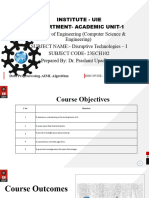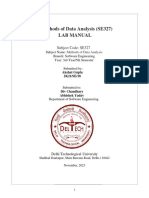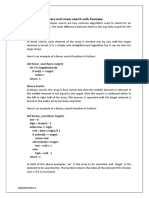Ml_Python_Basics
Uploaded by
First NameMl_Python_Basics
Uploaded by
First Name1.
How does machine learning contribute to personalized recommendations on
streaming platforms like Netflix, and why is it considered a valuable application?
- Machine learning analyzes user behavior, watch history, and preferences to
recommend content. This improves user experience and engagement, making it a
valuable application for streaming services.
2. How do Anaconda, Jupyter Notebooks, and Google Colab contribute to the
development and implementation of Artificial Intelligence (AI) and Machine Learning
(ML) models?
- Anaconda: Provides a package manager and environment for ML development.
- Jupyter Notebooks: Allows interactive coding, visualization, and documentation
in one place.
- Google Colab: Cloud-based platform that supports GPU and TPU for efficient ML
model training.
3. What are the differences between lists and tuples? Write a program to implement
lists and tuples in Python.
- Lists: Mutable (modifiable), slower, use more memory.
- Tuples: Immutable (cannot be changed), faster, use less memory.
```python
# Example
my_list = [1, 2, 3]
my_tuple = (4, 5, 6)
print("List:", my_list)
print("Tuple:", my_tuple)
```
4. What are the differences between sets and dictionaries in Python?
- Sets: Unordered collection of unique elements.
- Dictionaries: Key-value pairs used to store and retrieve data efficiently.
5. Explain the differences between NumPy, SciPy, and Pandas in Python numerical
computation.
- NumPy: Used for numerical computations and arrays.
- SciPy: Built on NumPy, used for advanced scientific computations.
- Pandas: Used for data manipulation and analysis.
6. Describe the primary data structures used in NumPy, SciPy, and Pandas, and
provide examples of their applications.
- NumPy: Uses arrays (ndarray) for numerical operations.
- SciPy: Uses sparse matrices and optimization tools.
- Pandas: Uses DataFrames for structured data analysis.
7. Write code to create a Pandas Series.
```python
import pandas as pd
data = [10, 20, 30, 40]
series = pd.Series(data)
print(series)
```
8. Explain the importance of data visualization.
- Helps understand trends, patterns, and relationships in data.
- Makes complex data easier to interpret.
9. How to create a plot using Matplotlib?
```python
import matplotlib.pyplot as plt
x = [1, 2, 3, 4]
y = [10, 20, 25, 30]
plt.plot(x, y)
plt.xlabel("X-axis")
plt.ylabel("Y-axis")
plt.title("Simple Plot")
plt.show()
```
10. Explain the differences between Matplotlib and Seaborn.
- Matplotlib: Low-level library for detailed graph customization.
- Seaborn: High-level library that provides aesthetically pleasing statistical
visualizations.
11. Why is the Scikit-learn library useful?
- Provides simple and efficient tools for data mining and ML.
- Contains built-in models for classification, regression, and clustering.
12. What is Scikit-learn? What are some common machine learning tasks that can be
performed using Scikit-learn?
- Scikit-learn is an ML library built on NumPy and SciPy.
- Tasks: Classification, regression, clustering, dimensionality reduction, and
model evaluation.
You might also like
- Python Programming: General-Purpose Libraries; NumPy,Pandas,Matplotlib,Seaborn,Requests,os & sys: Python, #2From EverandPython Programming: General-Purpose Libraries; NumPy,Pandas,Matplotlib,Seaborn,Requests,os & sys: Python, #2No ratings yet
- Machine Learning Using Python: Lab Record Name-Reg.No ratings yetMachine Learning Using Python: Lab Record Name-Reg.14 pages
- Essential Python Libraries and Functions For Data Science 1706295212No ratings yetEssential Python Libraries and Functions For Data Science 170629521212 pages
- Report Format (1) .Docx - 20240508 - 124537 - 0000No ratings yetReport Format (1) .Docx - 20240508 - 124537 - 000011 pages
- MCP Lab-2023 ContentForPythonLibrariesTopicNo ratings yetMCP Lab-2023 ContentForPythonLibrariesTopic9 pages
- 5616-1700040380952-HND - APDD - W10 - Data Structures and Data Analysis Libraries in PythonNo ratings yet5616-1700040380952-HND - APDD - W10 - Data Structures and Data Analysis Libraries in Python16 pages
- Machine Learning with Python: A Comprehensive Guide with a Practical ExampleFrom EverandMachine Learning with Python: A Comprehensive Guide with a Practical ExampleNo ratings yet
- Esc Enter M Y A B D + D Z F Shift + Up/Down Space Shift + SpaceNo ratings yetEsc Enter M Y A B D + D Z F Shift + Up/Down Space Shift + Space12 pages
- slidesgo-revolutionizing-retail-the-smart-shopping-cart-powered-by-iot-20250124162746NOgPNo ratings yetslidesgo-revolutionizing-retail-the-smart-shopping-cart-powered-by-iot-20250124162746NOgP12 pages
- Evos m7000 Cell Imaging System Spec SheetNo ratings yetEvos m7000 Cell Imaging System Spec Sheet2 pages
- BioMASS v2.0 A NEW TOOL FOR BIOPROCESS SIMULATIONNo ratings yetBioMASS v2.0 A NEW TOOL FOR BIOPROCESS SIMULATION205 pages
- 3D Scanning and Imaging For Quick Documentation of Crime and Accident ScenesNo ratings yet3D Scanning and Imaging For Quick Documentation of Crime and Accident Scenes14 pages
- Organizational Management and Integration: Presented by - Divyasri GNo ratings yetOrganizational Management and Integration: Presented by - Divyasri G135 pages
- Download ebooks file Spatial Synthesis Computational Social Science and Humanities Xinyue Ye all chapters100% (3)Download ebooks file Spatial Synthesis Computational Social Science and Humanities Xinyue Ye all chapters55 pages
- Runtime Error Behavior: Using The Development EnvironmentNo ratings yetRuntime Error Behavior: Using The Development Environment1 page
- For General-Purpose Transaction Weighing: Application VersatilityNo ratings yetFor General-Purpose Transaction Weighing: Application Versatility4 pages
- Use and Protection of Intellectual Property in Online BusinessNo ratings yetUse and Protection of Intellectual Property in Online Business24 pages





























































































